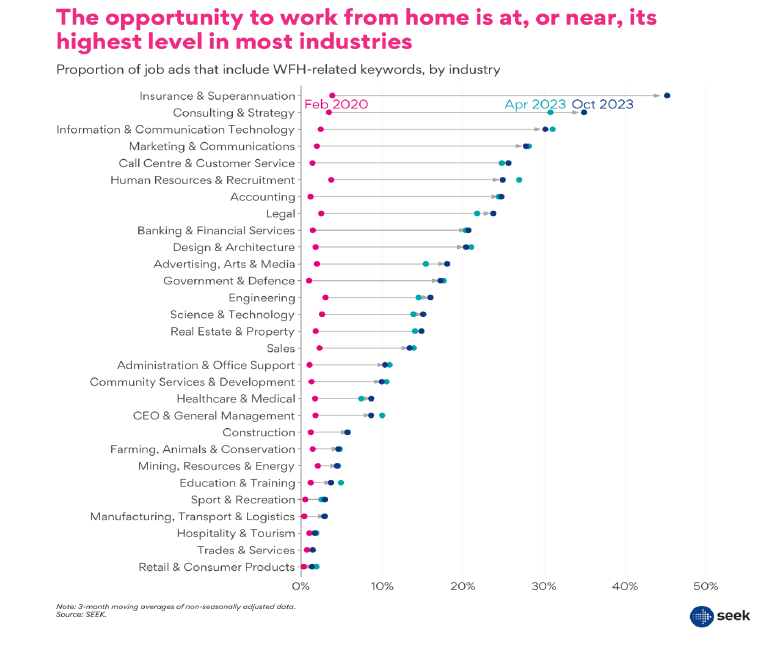White collar WFH here to stay at peak levels: Seek
AppointmentsAnalysis of job adverts shows the ability to work from home at least some of the time has barely receded from its post-pandemic peak.

Jobs touting the ability to work from home are running at near-peak levels two years after the end of lockdowns and in some professions such as accounting have hit a post-Covid high, an analysis of Seek data reveals.
Seek senior economist Matt Cowgill said February 2020, just 1.6 per cent of jobs featured WFH but the overall figure now was 10 per cent and much higher in white collar roles.
“The WFH rate rose sharply during the initial lockdown period and kept on rising,” he said. “Since lockdowns ended in Australia in October 2021, there's been no sign of remote work returning to anything like the pre-Covid levels.”
“On the contrary, the WFH rate kept rising long after lockdowns were over. The rate rose from a little over 6 per cent of job ads in late 2021 to a peak of 11 per cent in April 2023.”
He said correcting for the types of jobs on offer showed only a marginal decline from that peak and revealed that WFH – for at least some of the time – was not simply a perk to lure candidates when the labour market was tight.
“Even as the market is moving to a more normal balance between supply and demand, the proportion of job ads offering the ability to work from home has remained high.”
In some sectors, the WFH rate had risen or stabilised at a high level.
“For example, 45.2 per cent of job ads in finance and insurance in October 2023 indicated they could be done from home - unchanged from the peak in April 2023 and dramatically higher than the 3.8 per cent recorded in February 2020,” he said.
“The WFH rate in consulting and strategy was 34.9 per cent in October, up from 30.8 per cent in April.”
For accounting, the October figure has edged ahead of its April peak of 24.4 per cent to 24.8 per cent. Before the pandemic, the rate was just 1.2 per cent.

Where the WFH rate fell between April and October 2023, it was generally small. In information and communication technology, for example, it fell from 31 per cent in April to 30 per cent in October.
The data also showed WFH was more common in the big states, with 12.6 per cent of jobs in NSW compared to just 6.6 per cent in Western Australia.
“The differences between the states are mostly driven by differences in the mix of jobs, with collar professional jobs in industries like finance, consulting and ICT being a bigger share of the workforce in NSW and Victoria than in other states.”
Mr Cowgill said the experience of lockdowns appeared to have little influence on today’s WFH level, with the rate in NSW actually higher than in Victoria, despite its extensive periods of shutdown during the pandemic.
Pedestrian levels in capital CBDs were also revealing, with foot traffic in the centre of Melbourne 50-60 per cent below 2019 levels according to the city’s own figures.
Australia also appeared to be in line with other developed economies, even the data was identified differently.
“Comparisons between the level across countries may not be meaningful,” Mr Cowgill said. “But the comparison within countries over time is informative, and the trends broadly similar.”
“Working from home shows no sign of receding to anything like pre-Covid levels. Each country remains around a similar level as in 2022.”
Seek measured the WFH rate by counting how many job ads indicated that the role can be done remotely, as a proportion of all job ads in a particular month.




